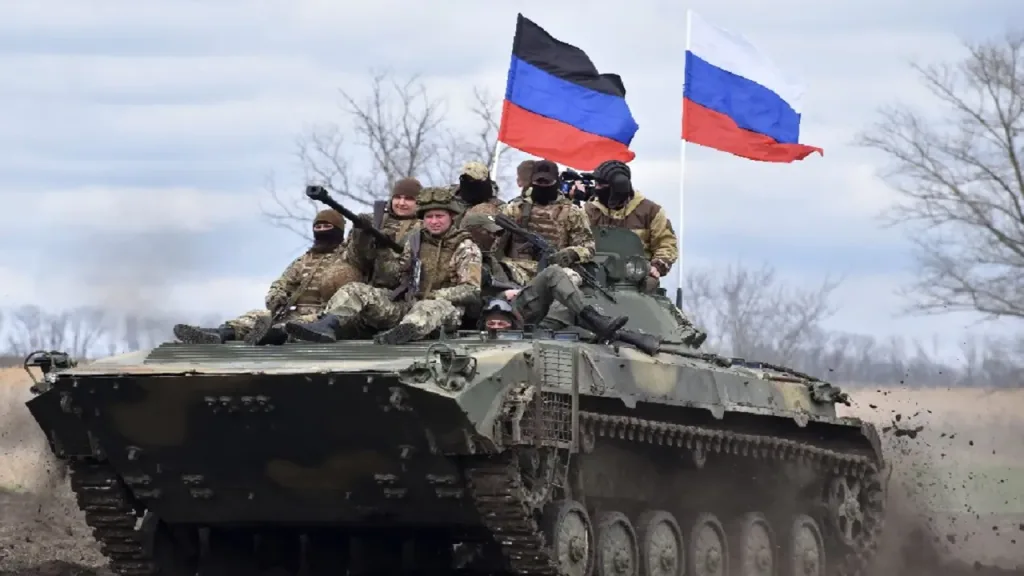
Soldiers on an armored personnel carrier (APC) carrying the flag of the Russian Federation and the flag of the Donetsk People's Republic. Photo: New Eastern Outlook.

Orinoco Tribune – News and opinion pieces about Venezuela and beyond
From Venezuela and made by Venezuelan Chavistas

Soldiers on an armored personnel carrier (APC) carrying the flag of the Russian Federation and the flag of the Donetsk People's Republic. Photo: New Eastern Outlook.
By Brian Berletic – Oct 21, 2025
Russia’s gradual advance in the Donbass region appears to be forming an operational encirclement of Ukraine’s last major defensive line—its “fortress belt”—a development that could decide not only the fate of the war but also the shape of the emerging global order.
Russian forces in recent weeks have been increasingly encircling the cities of Pokrovsk in central Donetsk while approaching Lyman and Siversk further to the north. Looking at various live mapping projects tracking the ongoing conflict in Ukraine, nascent pincers appear to be emerging in what some analysts believe could be a large-scale encirclement of what remains of Ukraine’s “fortress belt” in the Donbass region.
Comprising a number of heavily-defended built-up urban centers from Kostiantynovka and extending northward toward Kramatorsk and Slovyansk closer to Lyman, Ukraine’s remaining fortress belt likely comprises thousands, perhaps tens of thousands of Ukrainian forces. Their encirclement by Russian forces would deal a catastrophic defeat to Ukraine and its US sponsors and signify the achievement of a major Russian objective amid its ongoing Special Military Operation (SMO) – the full capture of the Donbass region.
Over the next weeks and months, the fate of this military operation will be decided, both on the battlefield in the Donbass region, far beyond it in the strategic depths of both Ukraine and Russia, as well as geopolitically worldwide.
Realities of a Major Donbass “Encirclement”
While many may imagine a World War 2-style physical encirclement of Ukraine’s fortress belt by rolling columns of Russian armored and infantry units, the encirclement will much more likely take the form of an operational, rather than physical envelopment.
Russian ground forces will continue their incremental advance along the line of contact, approaching Ukrainian-held towns and cities, besieging them, and eventually taking them, ensuring salients that emerge are well-protected from Ukrainian-counter attack as well as from the sort of operational envelopment Russia itself has been and seeks to continue to impose on Ukrainian forces.
Instead, Russian long-range warfare capabilities and drone warfare in particular – which has evolved rapidly in terms of both quality and quantity – will be able to target Ukraine’s line of communications along the entire rear of its remaining fortress belt. With the inevitable fall of Pokrovsk to Russian forces in central Donetsk and Russian forces approaching Lyman in the north, Russian FPV (first-person view) and fiber optic drones will be in range of virtually everything in between.
The encirclement of Pokrovsk and the emerging salient extending north reaching almost directly west of Kostiantynovka has already compromised logistics for Kostiantynovka itself. As Russian forces consolidate control in this region, drone operations targeting logistics for Kramatorsk and Slavyansk will become increasingly effective together with Russian forces doing likewise while moving from north to south near Lyman and Siversk.
Washington’s ‘Golden Dome’ – Multi-Trillion Tax Dollar Heist at Best, Dangerous Provocation at Worst
The closer these pincers get to one another, the more effective operational encirclement will become and the more precarious Ukrainian positions will become in between them.
Just as Pokrovsk itself does not require complete physical encirclement by Russian forces to severely compromise Ukrainian logistics and thus undermine defensive positions inside the city, Russia does not necessarily need to physically encircle the Kramatorsk-Slavyansk section of Ukraine’s fortress belt to severely compromise both logistics for it and military positions within it.
In some ways, an operational encirclement would be preferable to a physical envelopment.
Because Russia is fighting what is essentially a war of attrition seeking to demilitarize Ukraine rather than focusing on the rapid seizure of territory, it seeks to force Ukraine to commit huge amounts of reserves to Pokrovsk and elsewhere along the fortress belt to meet well-established Russian military positions and long-range fires.
A rapid Russian advance toward the Dnieper River or beyond, would be costly and would afford what remains of Ukraine’s forces the ability to operate closer and closer to their own base of material support along its border with NATO. Instead, Ukraine is forced to continuously send troops and material to the current line of contact where Russia is destroying it.
Western Actions On and Beyond the Battlefield
The Western media now accepts that Russia is both fighting and decisively winning this war of attrition and that there is little the US and its European client states can do to stop it – at least in terms of continued military support for Ukrainian forces.
This is why the US and Europe have insisted on a ceasefire and what would essentially be a “Minsk 3.0” freeze during which the collective West would expand its own military industrial production, and just like during the first Minsk agreements, rebuild Ukraine’s armed forces for the next round of hostilities.
Russia’s rejection of a ceasefire and continued successful military operation inside Ukraine has forced the US to both escalate on the battlefield and turn toward means beyond the battlefield in Ukraine to force a freeze or, short of that, raise the cost as high as possible for Russia to continue its SMO.
One option has been the threat of sending Tomahawk cruise missiles to Ukraine. Not a war-winning capability in and of itself, its introduction would once again incrementally increase the cost of continuing the conflict for Russia forcing it to reorganize its air defenses to defend deeper inside Russian territory and possibly slowing down the progress of operations along the front line. The missiles could also perhaps strike at and inflict larger-scale damage on Russian military industrial and energy production infrastructure than ongoing US-directed drone and missile strikes already have.
Together with this escalation on the battlefield, the US has also threatened a range of sanctions and tariffs aimed both at Russia itself as well as at its closest trading partners, especially India and China.
The threats are aimed at forcing India or China (ideally both) to choose access to US markets and its US dollar-dominated global financial system over trade with Russia, thus isolating Russia and making it infinitely more difficult for Russia to continue its military operations in Ukraine. Should India and China cave to US demands and Russia find itself isolated or even collapse economically and politically, this would further isolate both India and China themselves – a key component of US strategic sequencing and its ultimate objective of preventing all rivals (ally or adversary) from rising to prominence.
Should India and China stand firm, the US imposed sanctions and tariffs would do short-term damage to both India and China but also to the US itself. Washington’s significant escalation in terms of sweeping sanctions and tariffs potentially accelerates the long-term trend toward a multipolar economic order.
The immediate challenge to nations like India and China – being cut off from the US dollar and Western markets – forces a rapid diversification of trade and financial settlement systems which has already been ongoing since the inception of BRICS. This additional US strategic pressure, intended to inflict short-term pain on Russia, inadvertently incentivizes and hastens the development of non-Western alternatives, including to the US dollar and US-dominated payment systems.
The battle for Ukraine’s fortress belt is thus a microcosm of the larger US proxy war in Ukraine against Russia – a slow, grinding military operation that dictates massive geopolitical consequences. The outcome of this battle will likely cement the overall outcome of the Ukraine conflict itself. More broadly, the US response, pivoting from military containment to economic warfare against Russia’s global partners, confirms that this conflict has always been just one part of a much larger US strategy toward its ultimate aim of eliminating rivals and maintaining primacy worldwide.
The coming months will be pivotal not just in terms of the ongoing conflict in Ukraine, but in terms of the global order that emerges as part of the larger conflict the US is fighting against not just Russia but the entire multipolar world.

Brian Berletic is a Bangkok-based geopolitical researcher and writer who hosts The New Atlas; former US marine officer. For over ten years he wrote under the pseudonym 'Tony Cartalucci.'
Support Groundbreaking Anti-Imperialist Journalism: Stand with Orinoco Tribune!
For 7 years, we’ve delivered unwavering truth from the Global South frontline – no corporate filters, no hidden agenda.
Last year’s impact:
• More than 200K active users demanding bold perspectives
• 216 original pieces published in 2025 alone
Fuel our truth-telling: Every contribution strengthens independent media that actually challenges imperialism.
Be the difference: DONATE now to keep radical journalism alive!